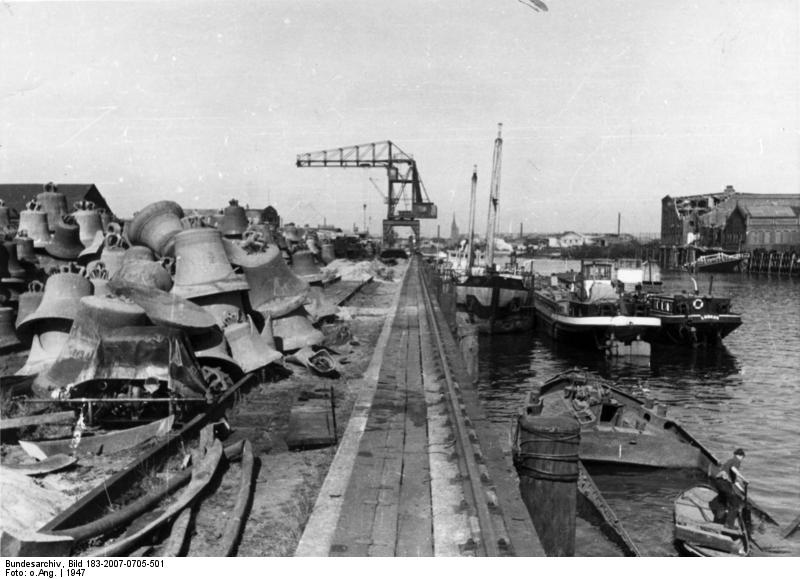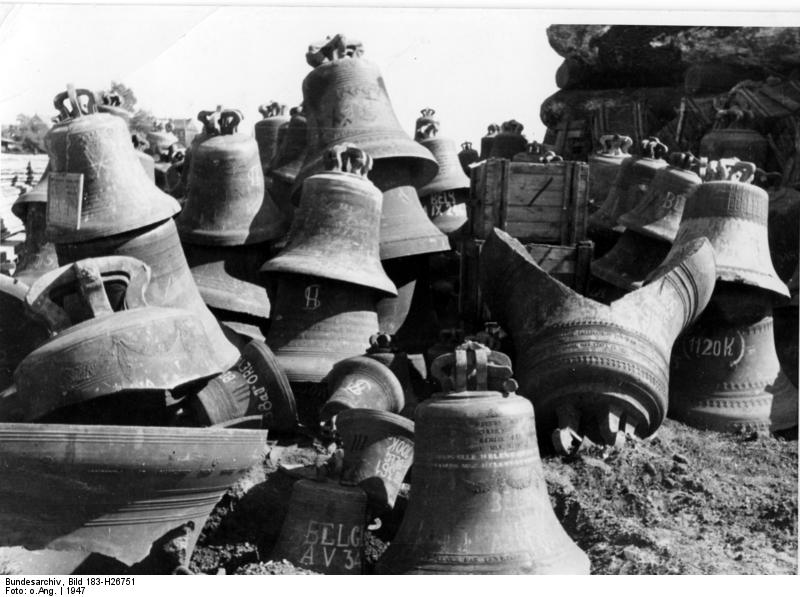The Bell Cemeteries of World War 2
Nearly every German family in every German town contributed something to the two World Wars. For many, it was their men. For others, it was precious metal.
“I gave gold for iron” became the slogan of the collection campaign launched in 1914, in which the Germans were asked to donate materials essential to the war effort. The slogan has its origins in the War of the Sixth Coalition fought by the Kingdom of Prussia and its allies, in 1813-14, to achieve liberation of Germany from French occupation. During the war, Princess Marianne of Prussia appealed to all women of Prussia to exchange their gold jewelry for a brooch or a ring made of iron with the inscription “I GAVE GOLD FOR IRON” which the women could flaunt as a symbol of their patriotism.

Church bells of all sizes await their fate in a “bell cemetery” in Wilten, Austria. Photo: Stadtarchiv / Stadtmuseum Innsbruck
During the First World War, the call for gold went out again, and like before, many German women voluntarily gave up their jewelries and wedding rings in exchange of an iron ring, and later, medals inscribed with the same slogan. But as the war dragged on and shortage of metals became acute, the Berlin War Ministry ordered that all metals including copper, brass, tin, zinc, etc., needed for the manufacture of ammunitions and armament, be handed over. Failure to do so could attract up to a year in prison.
Besides pots, pans and statues, church bells all over the country began to disappear. By decree, all parishes in the German Reich were initially asked to provide a list of all bronze bells or bells of made of other copper alloys in their possession. Churches were allowed to keep the insignificant bells, usually those smaller than 25 cm. Also spared were bells used for signaling purposes on railways and ships. Depending on their art-historical value, the bells were assigned to one of three categories. Group A bells with little cultural value were melted immediately. Group B with moderate cultural and historical value was initially put on hold, and bells of Group C were considered protected.

Bell cemetery in the Wilten district of Innsbruck, around 1917. Photo: Grassmayr Bell Museum/Wikimedia Commons
During the Second World War, the Nazi administration classified the bells into types A, B, C and D. Types C and D represented historically valuable bells. While A and B had to be surrendered immediately, type C bells were put on hold awaiting examination by art historians for their cultural value, whereas type D was protected. Only one bell was allowed per church, usually the lightest. Bells from the 16th and 17th centuries and from the Middle Ages were generally spared.
After the bells were removed from the towers, they were taken by ships and freight trains to one of the two large smelting works in Hamburg. Other copper smelters in Oranienburg, Hettstedt, Ilsenburg, Kall and Lünen also received a fair share of bells. These smelters had large holding areas where the bells waited to be taken to the furnace and converted back into bronze ingots. They were called bell cemeteries or Glockenfriedhof.
“The so-called bell cemeteries, where the bells were laid to rest before they fell victim to destruction, had something inexpressibly melancholy,” says bell specialist Kramer, quoting a contemporary witness in his book Sounds of Infinity. Smaller bells were smashed with hammers, larger ones blown up: “Usually the bell rang again at the moment it was blown, as if it had made its last wail.”

Confiscated bells amass at Hamburg harbor. Photo: Germanisches National Museum.
After the end of World War 2, around 13,000 bells that were confiscated but not melted still remained in bell cemeteries.
In 1947, the Allied authorities set up a committee called Ausschuss für die Rückführung der Glocken (or ARG) whose objective was to safeguard the remaining bells and coordinate their return to their respective parishes. The ARG was involved in the return of bells only to the French and Soviet occupation zones. The return of bells confiscated in the later years of the war from the occupied territories (Belgium, France, Italy, the Netherlands, Austria, Poland, Czechoslovakia and Hungary) was overseen by the occupying powers.
In just six years, nearly all the bells were returned to the former communities, as far as they could still be identified.

Confiscated bells amass at Hamburg harbor. Photo: Wikimedia Commons

Confiscated bells amass at Hamburg harbor. Photo: Wikimedia Commons
In addition to securing the still intact bells, the committee also took over the collection of broken bells from the Germans. In the largest German bell warehouse in Hamburg, there were still around 150 tons of broken bells that had been caused by bombing the warehouse. These were given to communities in East Germany, where they were distributed to the churches whose bells were confiscated. The rest was handed over to the regional churches in the Federal Republic, which suffered particularly heavy losses.
Many communities hid their bells instead of handing them over to the Nazis. These bells make news even today when they are unearthed or rediscovered.
News
The Hanging Temple: China’s 1,500-Year-Old Cliffside Marvel of Faith and Engineering
The Hanging Temple: China’s 1,500-Year-Old Cliffside Marvel of Faith and Engineering Perched precariously on the cliffs of Mount Heng in Shanxi Province, China, the Hanging Temple, also known as Xuankong Temple, Hengshan Hanging Temple, or Hanging Monastery, is an architectural…
The Willendorf Venus: A 30,000-Year-Old Masterpiece Reveals Astonishing Secrets
The Willendorf Venus: A 30,000-Year-Old Masterpiece Reveals Astonishing Secrets The “Willendorf Venus” stands as one of the most revered archaeological treasures from the Upper Paleolithic era. Discovered in 1908 by scientist Johann Veran near Willendorf, Austria, this small yet profound…
Unveiling the Maya: Hallucinogens and Rituals Beneath the Yucatán Ball Courts
Unveiling the Maya: Hallucinogens and Rituals Beneath the Yucatán Ball Courts New archaeological research has uncovered intriguing insights into the ritual practices of the ancient Maya civilization. The focus of this study is a ceremonial offering found beneath the sediment…
Uncovering the Oldest Agricultural Machine: The Threshing Sledge’s Neolithic Origins
Uncovering the Oldest Agricultural Machine: The Threshing Sledge’s Neolithic Origins The history of agricultural innovation is a fascinating journey that spans thousands of years, and one of the earliest known agricultural machines is the threshing sledge. Recently, a groundbreaking study…
Nara’s Ancient Sword: A 1,600-Year-Old Protector Against Evil Spirits
Nara’s Ancient Sword: A 1,600-Year-Old Protector Against Evil Spirits In a remarkable discovery that has captured the attention of archaeologists and historians alike, a 7.5-foot-long iron sword was unearthed from a 1,600-year-old burial mound in Nara, Japan. This oversized weapon,…
The Inflatable Plane, Dropped Behind the Lines for Downed Pilots
Experimental The Inflatable Plane, Dropped Behind the Lines for Downed Pilots The Inflatoplane from Goodyear was an unconventional aircraft developed by the Goodyear Aircraft Company, a branch of the renowned Goodyear Tire and Rubber Company, also famed for the Goodyear…
End of content
No more pages to load











